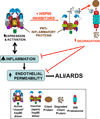Regulators of endothelial and epithelial barrier integrity and function in acute lung injury
- PMID: 19428331
- PMCID: PMC4474367
- DOI: 10.1016/j.bcp.2009.01.014
Regulators of endothelial and epithelial barrier integrity and function in acute lung injury
Abstract
Permeability edema is a life-threatening complication accompanying acute lung injury (ALI), severe pneumonia and the acute respiratory distress syndrome (ARDS), which can be associated with a reduced alveolar liquid clearance (ALC) capacity, a disruption of the alveolar epithelial barrier, and an increased capillary endothelial permeability. Bacterial and viral infections can directly promote pulmonary endothelial hyperpermeability and indirectly decrease the function and/or expression of ion transporters regulating ALC in type II alveolar epithelial cells, by means of inducing a strong inflammatory and oxidative stress response in the infected lungs. Apart from ventilation strategies, no standard treatment exists for permeability edema, making the search for novel regulators of endothelial and epithelial hyperpermeability and dysfunction important. Here, we present an overview of recently identified substances that inhibit and/or reverse endothelial barrier disruption and permeability or alveolar epithelial dysfunction: (1) zinc chelators, which were shown to attenuate the effects of oxidative stress on the pulmonary endothelium; (2) peroxisome proliferator activated receptor (PPAR) ligands, which have been shown to exert anti-inflammatory effects, by decreasing the expression of pro-inflammatory genes; (3) extracellular ATP, produced during inflammation, which induces a rapid and dose-dependent increase in transendothelial electrical resistance (TER) across pulmonary endothelial cells; (4) the lectin-like domain of TNF, which is spatially distinct from the receptor binding sites and which protects from hydrostatic and permeability edema and (5) Hsp90 inhibitors, which prevent and repair toxin-induced hyperpermeability. Unraveling the mechanism of action of these agents could contribute to the development of novel therapeutic strategies to combat permeability edema.
Figures




References
-
- Rudkowski JC, Barreiro E, Harfouche R, Goldberg P, Kishta O, D’Orleans-Juste P, et al. Roles of iNOS and nNOS in sepsis-induced pulmonary apoptosis. Am J Physiol Lung Cell Mol Physiol. 2004;286(4):L793–L800. - PubMed
-
- Wang S, Young RS, Sun NN, Witten ML. In vitro cytokine release from rat type II pneumocytes and alveolar macrophages following exposure to JP-8 jet fuel in co-culture. Toxicology. 2002;173(3):211–219. - PubMed
-
- Lionetti V, Recchia FA, Ranieri VM. Overview of ventilator-induced lung injury mechanisms. Current opinion in critical care. 2005;11(1):82–86. - PubMed
-
- Liu D, Zeng BX, Zhang SH, Wang YL, Zeng L, Geng ZL, et al. Rosiglitazone, a peroxisome proliferator-activated receptor-gamma agonist, reduces acute lung injury in endotoxemic rats. Crit. Care Med. 2005;33(10):2309–2316. - PubMed
Publication types
MeSH terms
Substances
Grants and funding
LinkOut - more resources
Full Text Sources
Other Literature Sources

